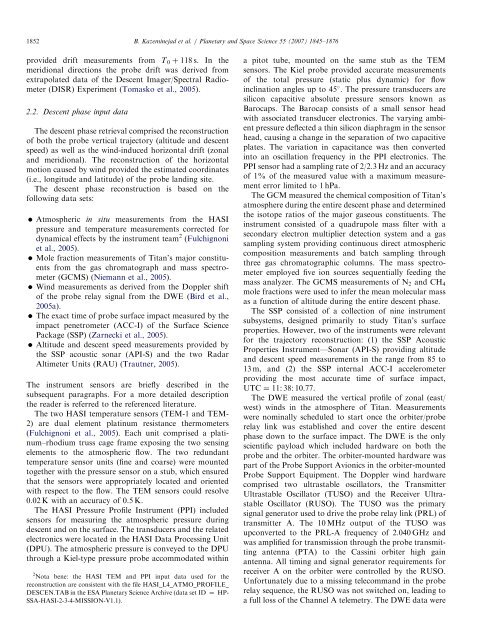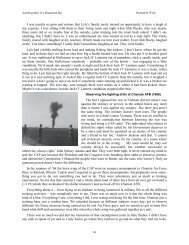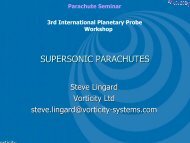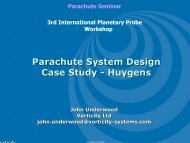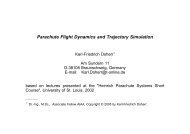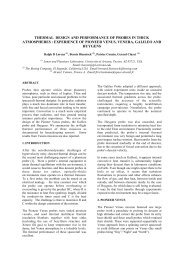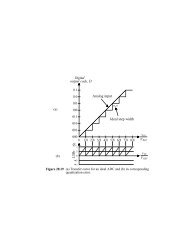Huygens' entry and descent through Titan's atmosphere ...
Huygens' entry and descent through Titan's atmosphere ...
Huygens' entry and descent through Titan's atmosphere ...
You also want an ePaper? Increase the reach of your titles
YUMPU automatically turns print PDFs into web optimized ePapers that Google loves.
1852<br />
provided drift measurements from T 0 þ 118 s. In the<br />
meridional directions the probe drift was derived from<br />
extrapolated data of the Descent Imager/Spectral Radiometer<br />
(DISR) Experiment (Tomasko et al., 2005).<br />
2.2. Descent phase input data<br />
The <strong>descent</strong> phase retrieval comprised the reconstruction<br />
of both the probe vertical trajectory (altitude <strong>and</strong> <strong>descent</strong><br />
speed) as well as the wind-induced horizontal drift (zonal<br />
<strong>and</strong> meridional). The reconstruction of the horizontal<br />
motion caused by wind provided the estimated coordinates<br />
(i.e., longitude <strong>and</strong> latitude) of the probe l<strong>and</strong>ing site.<br />
The <strong>descent</strong> phase reconstruction is based on the<br />
following data sets:<br />
Atmospheric in situ measurements from the HASI<br />
pressure <strong>and</strong> temperature measurements corrected for<br />
dynamical effects by the instrument team 2 (Fulchignoni<br />
et al., 2005).<br />
Mole fraction measurements of Titan’s major constituents<br />
from the gas chromatograph <strong>and</strong> mass spectrometer<br />
(GCMS) (Niemann et al., 2005).<br />
Wind measurements as derived from the Doppler shift<br />
of the probe relay signal from the DWE (Bird et al.,<br />
2005a).<br />
The exact time of probe surface impact measured by the<br />
impact penetrometer (ACC-I) of the Surface Science<br />
Package (SSP) (Zarnecki et al., 2005).<br />
Altitude <strong>and</strong> <strong>descent</strong> speed measurements provided by<br />
the SSP acoustic sonar (API-S) <strong>and</strong> the two Radar<br />
Altimeter Units (RAU) (Trautner, 2005).<br />
The instrument sensors are briefly described in the<br />
subsequent paragraphs. For a more detailed description<br />
the reader is referred to the referenced literature.<br />
The two HASI temperature sensors (TEM-1 <strong>and</strong> TEM-<br />
2) are dual element platinum resistance thermometers<br />
(Fulchignoni et al., 2005). Each unit comprised a platinum–rhodium<br />
truss cage frame exposing the two sensing<br />
elements to the atmospheric flow. The two redundant<br />
temperature sensor units (fine <strong>and</strong> coarse) were mounted<br />
together with the pressure sensor on a stub, which ensured<br />
that the sensors were appropriately located <strong>and</strong> oriented<br />
with respect to the flow. The TEM sensors could resolve<br />
0.02 K with an accuracy of 0.5 K.<br />
The HASI Pressure Profile Instrument (PPI) included<br />
sensors for measuring the atmospheric pressure during<br />
<strong>descent</strong> <strong>and</strong> on the surface. The transducers <strong>and</strong> the related<br />
electronics were located in the HASI Data Processing Unit<br />
(DPU). The atmospheric pressure is conveyed to the DPU<br />
<strong>through</strong> a Kiel-type pressure probe accommodated within<br />
2 Nota bene: the HASI TEM <strong>and</strong> PPI input data used for the<br />
reconstruction are consistent with the file HASI_L4_ATMO_PROFILE_<br />
DESCEN.TAB in the ESA Planetary Science Archive (data set ID ¼ HP-<br />
SSA-HASI-2-3-4-MISSION-V1.1).<br />
ARTICLE IN PRESS<br />
B. Kazeminejad et al. / Planetary <strong>and</strong> Space Science 55 (2007) 1845–1876<br />
a pitot tube, mounted on the same stub as the TEM<br />
sensors. The Kiel probe provided accurate measurements<br />
of the total pressure (static plus dynamic) for flow<br />
inclination angles up to 45 . The pressure transducers are<br />
silicon capacitive absolute pressure sensors known as<br />
Barocaps. The Barocap consists of a small sensor head<br />
with associated transducer electronics. The varying ambient<br />
pressure deflected a thin silicon diaphragm in the sensor<br />
head, causing a change in the separation of two capacitive<br />
plates. The variation in capacitance was then converted<br />
into an oscillation frequency in the PPI electronics. The<br />
PPI sensor had a sampling rate of 2/2.3 Hz <strong>and</strong> an accuracy<br />
of 1% of the measured value with a maximum measurement<br />
error limited to 1 hPa.<br />
The GCM measured the chemical composition of Titan’s<br />
<strong>atmosphere</strong> during the entire <strong>descent</strong> phase <strong>and</strong> determined<br />
the isotope ratios of the major gaseous constituents. The<br />
instrument consisted of a quadrupole mass filter with a<br />
secondary electron multiplier detection system <strong>and</strong> a gas<br />
sampling system providing continuous direct atmospheric<br />
composition measurements <strong>and</strong> batch sampling <strong>through</strong><br />
three gas chromatographic columns. The mass spectrometer<br />
employed five ion sources sequentially feeding the<br />
mass analyzer. The GCMS measurements of N2 <strong>and</strong> CH4<br />
mole fractions were used to infer the mean molecular mass<br />
as a function of altitude during the entire <strong>descent</strong> phase.<br />
The SSP consisted of a collection of nine instrument<br />
subsystems, designed primarily to study Titan’s surface<br />
properties. However, two of the instruments were relevant<br />
for the trajectory reconstruction: (1) the SSP Acoustic<br />
Properties Instrument—Sonar (API-S) providing altitude<br />
<strong>and</strong> <strong>descent</strong> speed measurements in the range from 85 to<br />
13 m, <strong>and</strong> (2) the SSP internal ACC-I accelerometer<br />
providing the most accurate time of surface impact,<br />
UTC ¼ 11: 38: 10:77.<br />
The DWE measured the vertical profile of zonal (east/<br />
west) winds in the <strong>atmosphere</strong> of Titan. Measurements<br />
were nominally scheduled to start once the orbiter/probe<br />
relay link was established <strong>and</strong> cover the entire <strong>descent</strong><br />
phase down to the surface impact. The DWE is the only<br />
scientific payload which included hardware on both the<br />
probe <strong>and</strong> the orbiter. The orbiter-mounted hardware was<br />
part of the Probe Support Avionics in the orbiter-mounted<br />
Probe Support Equipment. The Doppler wind hardware<br />
comprised two ultrastable oscillators, the Transmitter<br />
Ultrastable Oscillator (TUSO) <strong>and</strong> the Receiver Ultrastable<br />
Oscillator (RUSO). The TUSO was the primary<br />
signal generator used to drive the probe relay link (PRL) of<br />
transmitter A. The 10 MHz output of the TUSO was<br />
upconverted to the PRL-A frequency of 2.040 GHz <strong>and</strong><br />
was amplified for transmission <strong>through</strong> the probe transmitting<br />
antenna (PTA) to the Cassini orbiter high gain<br />
antenna. All timing <strong>and</strong> signal generator requirements for<br />
receiver A on the orbiter were controlled by the RUSO.<br />
Unfortunately due to a missing telecomm<strong>and</strong> in the probe<br />
relay sequence, the RUSO was not switched on, leading to<br />
a full loss of the Channel A telemetry. The DWE data were


